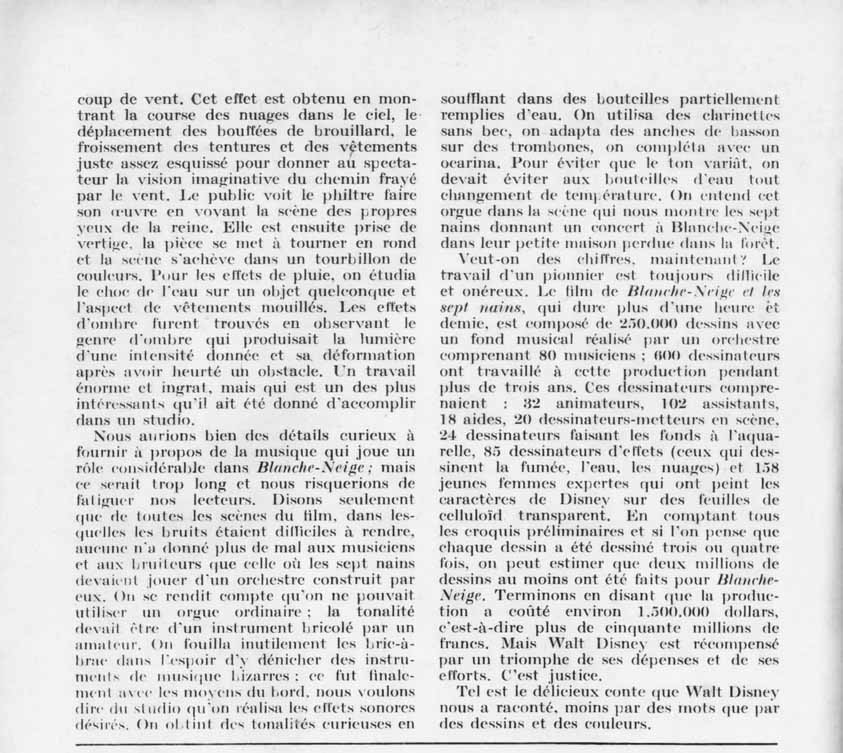Ciné-Miroir was a French weekly cinema publication published from 1922 to 1940, and again from 1946 to 1953.
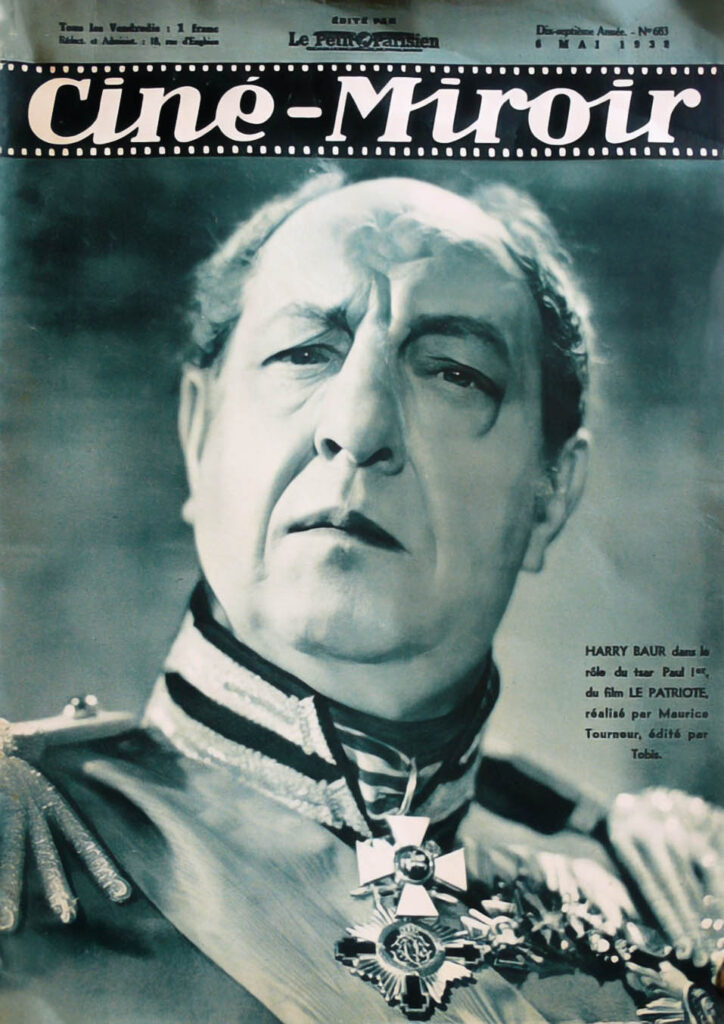
May 6, 1938
While the film was being released exclusively in Paris, Ciné-Miroir introduced the characters to its readers in issue no. 683 of May 6, 1938, with actor Harry Baur on the cover. The author kept the English names of the dwarfs in the original French text.
Walt Disney brings us a new color cartoon: Snow White and the Seven Dwarfs.
by R.M. (May 6, 1938)
You’re probably familiar with the charming fairy tale Snow White and the Seven Dwarfs. The famous cartoonist Walt Disney, the father of Mickey, Minnie, Donald and other well-known characters, turned it into a full-color cartoon film currently playing at the Marignan-Pathé in Paris. The film took four years to make and cost a million and a half dollars. This is the first time a work of this scale has been presented to the public.
Snow White and her companions occupy the screen for over two hours. As you’ll see, Walt Disney has remained as faithful as possible to the Grimm fairy tale so beloved by children.
He has, however, toned down the terrifying elements of the original story. Princess Snow White does not endure all the torture inflicted on her by her wicked stepmother in the fairy tale. She is not half-smothered by the vixen, and the terrible poison comb does not penetrate her hair. Only one of the wicked old woman’s misdeeds remains: she persuades the unfortunate Snow White to bite the enchanted apple that will plunge her into an eternal sleep.
So one day,” says Walt Disney, “towards the end of 1933, I set off for the land of fantasy, a land that’s not on any map, a promised land of happiness and gaiety.
My expedition was proving hazardous. Would I be able to bring it to a successful conclusion? Snow White was charming, gentle and attentive as befits a princess, but the little dwarfs were shy and timid. My collaborators shared my enthusiasm, and were as eager as I was to create the right atmosphere for Snow White and her curious little friends.
Hundreds of sets and models were designed, and only the best were kept. Lively music was composed and, in 1935, I finally had my little dwarfs. I could see them up close and hear them speak, just as I had imagined them when I read the first pages of the book. They looked so little alike that it took me months of study and observation to analyze and understand them. Today, at last, they speak, they chat, they live on the screen:
Doc sees himself as their leader; he’s pedantic and full of self-importance.
Happy is perhaps the most convenient. He’s a chubby little fellow who’s always cheerful and has a smile on his face.
Grumpy, on the other hand, is the real leader of the gang. He’s always in a bad mood and hates women.
Sleepy is always yawning and living with his eyes half-open.
Dopey is a little “zany” and likes to let himself go, playing jokes on everyone. He wears a canary-yellow doublet with a lavender-gray hat.
Poor Sneezy suffers from hay fever and sneezes at the most inopportune times.
Bashful is a great success with the ladies. He has a very good heart, is always willing to help and is excessively romantic.”
Along with the Evil Queen and Prince Charming, these are the main characters Walt Disney met on his four-year journey to the enchanted land. He presents them to us today with an art that is uniquely his own, and we derive maximum joy from it.


December 1939
Ciné-Miroir, a French cinema periodical, unveils its 256-page 1939 almanac featuring captivating covers adorned by stars Danielle Darrieux, recently renowned for her film released in the USA, “The Rage of Paris,” and Corinne Luchaire, now somewhat overshadowed due to her father, Jean Luchaire’s later role in collaboration during subsequent years. The almanac delves into various cinematic topics that were in vogue at the time, including features on Greta Garbo, Charles Trenet, the military’s role in cinema, and, of course, Snow White.
As of the publication of this article, the film has already been enchanting French audiences for nearly 8 months, continuing its triumphant success on numerous screens. The almanac’s format, a year-end booklet that not only recaps the past but also anticipates the upcoming year, allows for extensive articles, and this one is no exception. The unsigned text primarily focuses on narrating the film’s story in a style reminiscent of a children’s book. Towards the end, however, it offers insightful information and production figures that remain relevant today, drawn from an article previously published in Cinémonde. Here is the text:
Snow White and the Seven Dwarfs
by unknown journalist (December 1939)
Anyone who has admired Walt Disney’s marvelous film will be happy, we think, to reread the story of Snow White and the Seven Dwarfs; those who have not had this joy will feel, at the recounting of the little fairy’s adventures, an emotion that, for a few moments, will take them out of the down-to-earth, everyday life that is that of human beings. Walt Disney’s film is like a rainbow, illuminating our lives for a few minutes with its poetry, its light and its color. The great cartoon director has outdone himself. He may have created his masterpiece, but before we tell you how he did it, we want to entertain and rejuvenate you with a beautiful fairy tale. Listen, young and old, to the touching adventures of Snow White and the Seven Dwarfs.
So why was she called Snow White, the delicious little girl with cherry-red lips, shiny black ebony hair and long curled eyelashes? For in everything, we must begin at the beginning. Now, in a northern landscape lived a noble queen, who spent her time embroidering. It was cold outside, and she was all the more intent on her work because she was carrying a child in her womb, and she thought that the beautiful, colorful and cheerful designs would embellish the clothes of the baby to be born. One day, as she worked, the queen watched the snow fall on the ground, covering it with a vast white mantle, and she wanted to take a closer look at this immaculate and silent nature. She opened the window and leaned out. Then she pricked her finger and three drops of blood made a crimson stain on the snow. The effect was very pretty; it struck the queen and she began to think:
– I wish I had a child whose face, mingled with carmine, would be so framed in black.
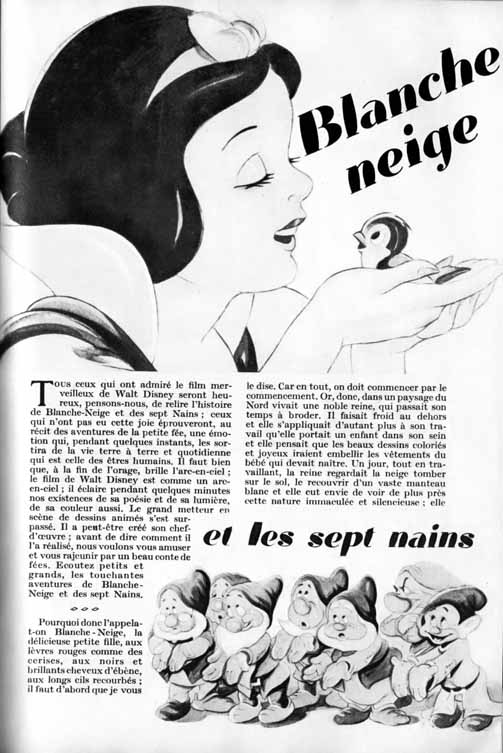
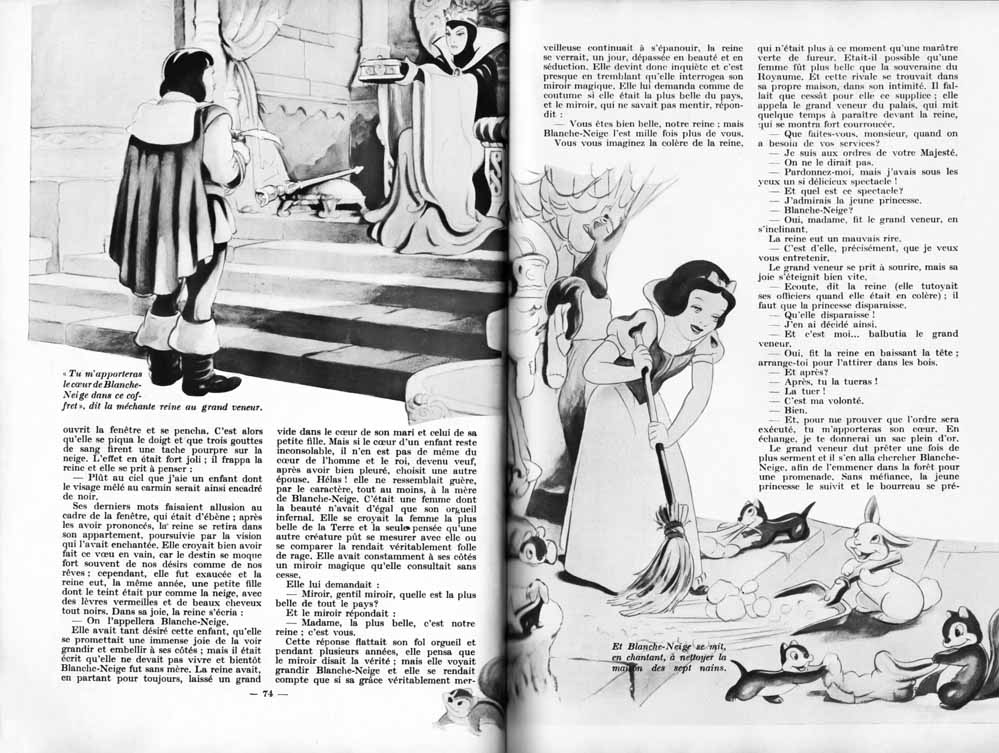
Her last words alluded to the window frame, which was made of ebony; after uttering them, the queen withdrew to her apartment, pursued by the vision that had enchanted her. She thought she had made this wish in vain, for fate often mocks our wishes as well as our dreams. However, she was granted it, and the same year the queen had a little girl with a complexion as pure as snow, with ruddy lips and beautiful black hair. In her joy, the queen exclaimed:
– We’ll call her Snow White.
She had longed for this child so much that she promised herself immense joy at seeing her grow up and become beautiful by her side; but it was written that she was not to live, and soon Snow White was without a mother. The Queen had left a great emptiness in the hearts of both her husband and her little daughter. But if a child’s heart remains inconsolable, the same cannot be said of a man’s, and the widowed king, after much mourning, chose another wife. Alas, she bore little resemblance, in character at least, to Snow White’s mother. She was a woman whose beauty was matched only by her infernal pride. She believed herself to be the most beautiful woman on Earth, and the very thought that any other creature could measure up or compare with her drove her mad with rage. She kept a magic mirror by her side at all times, which she consulted incessantly.
She would ask it:
– Mirror, mirror, who is the most beautiful in all the land?
And the mirror would answer:
– Madam, the most beautiful is our queen; it’s you.
This answer flattered her foolish pride, and for several years she thought the mirror was telling the truth; but as she watched Snow White grow, she realized that if her truly marvelous grace continued to blossom, the queen would one day find herself surpassed in beauty and seduction. So she became anxious, and almost trembling, questioned her magic mirror. As usual, she asked it if she was the most beautiful in the land, and the mirror, which knew no lies, replied:
– You are beautiful, our queen, but Snow White is a thousand times more beautiful than you.
You can imagine the wrath of the queen, who was now nothing more than a green stepmother. Was it possible for a woman to be more beautiful than the sovereign of the kingdom? And this rival was in her own home, in her intimacy. She had to put an end to this ordeal, so she called for the Huntsman of the palace, who took some time to appear before the queen, who showed great wrath.
– What do you do, sir, when your services are required?
– I’m at Your Majesty’s service.
– It doesn’t look like it.
– Forgive me, but I had before my eyes such a delicious spectacle!
– And what was that spectacle?
– I was admiring the young princess.
– Snow White?
– Yes, Madam,” said the Huntsman, bowing.
The queen laughed out loud.
– It’s precisely her I want to talk to you about.
The Huntsman smiled, but his joy soon faded.
– Listen,” said the queen (she was very informal with her officers when she was angry), “the princess must disappear.
– Let her disappear!
— I’ve decided it.
– And it’s me…” stammered the Huntsman.
– Yes,” said the queen, lowering her head, “arrange to lure her into the woods.
– And then what?
– Then you kill her
– Kill her!
– That’s my wish.
– Very well, then.
– And to prove to me that the order will be carried out, you will bring me her heart. In exchange, I’ll give you a bag full of gold.
The Huntsman had to swear an oath once again, and he set off to fetch Snow White and take her for a walk in the forest. Unsuspecting, the young princess followed him, and the executioner prepared for her assassination; the Queen, who was the cruelest of women, could not be resisted. So, when they reached a dark thicket that hid them from view, the Huntsman rushed at Snow White, dagger high. The girl shrieked and clasped her hands together with such sincerity, modesty and fear, that the criminal dropped his weapon. He felt moved by such innocence.
– Stay in the forest,” he told the young princess, “and don’t go back to the palace if you want to live.
At sixteen, everyone wants to live. The Huntsman left the young girl, killed a deer and ripped out its heart, bringing it to the queen, who could not hide her triumph at receiving the gift.
Meanwhile, Snow White wondered what would become of her, alone and lost in the forest, threatened by countless dangers. She was standing there, feverish, overwhelmed by loneliness, when she heard the howling of wolves and the growling of bears; in the shadows, owls stared at her with their round, shining eyes. It was enough to make Snow White tremble. She ran without knowing where, tearing her clothes and feet on the brambles and stones of the paths. However, after a breathless run, she stopped; the wild beasts had not pounced on her. They meant her no harm. The chirping birds, the supple fallow deer, the happy squirrels, the tumbling rabbits and the elegant roe deer were all eager to prove their friendship, and she followed them to a clearing where there was a small cottage. Who could live there? Snow White did not enter without some trepidation, but she was surprised to find no one at home and to find herself in a dwelling furnished with tiny chairs, tables and beds; she wanted to sleep, but before lying down, Snow White wanted to tidy things up. Things didn’t take long, as her friends, the forest animals and woodland birds, helped her with the housework, and in no time at all, the dust was gone, the dishes were done and the house was shining like a new penny. By now, Snow White had earned her rest; she said her prayer and fell sound asleep.
Snow White was fast asleep when the inhabitants of the cottage returned.
They were seven gnomes, or rather seven dwarfs, digging holes in the mountains for gold and jewels; they were seven benevolent, elusive little creatures, seven spirits of nature unaccustomed to living with humans. When they pushed open the door, they were astonished to see their house clean and tidy. Who had entered their home? To tell the truth, their joy at this unexpected tidiness was replaced by concern… It was not without trepidation that they climbed the stairs to their bedroom. What would they discover, my lord? They slipped into the room and stifled cries of admiration at the sight of the little princess asleep; they had never seen a human being so impressive in grace and beauty. They didn’t dare interrupt the girl’s sleep and wisely went off to bed.
It was Snow White who awoke first, and as she opened her eyes, she smiled at the seven little dwarfs; she got up and walked past their beds, at the foot of which each gnome had his name inscribed. When she spotted a little gnome afflicted with a cold that forced him to sneeze whenever he shouldn’t, she said:
– You’re Sneezy I
To the one who blushed whenever she spoke to him, she said:
– And you, Bashful.
To another who couldn’t lift his heavy eyelids and always seemed beside the point in their conversations, she added:
– And you, Sleepy.


There was a fat, round little dwarf, always happy.
– You’re Happy.
Another, brave but not very clever, who talked nonsense as big as his nose and always thought he was the strongest of his companions:
– You’re Doc,” said Snow White.
She called out the names of the other two; the leader of the gang, a gruff, withdrawn dwarf who hated women; he was called Grumpy; the youngest was called Dopey, always in a good mood, but a bigger ninny than you’d expect.
As it happened, the seven dwarfs were quickly won over by Snow White’s grace and kindness. She told them of her misfortunes, which they listened to with emotion, and when she had finished, she offered her services to the seven dwarfs, if they would keep her with them.
– I’ll look after your house.
– Yes,” said most of the dwarfs.
– I’ll cook for you and make you delicious desserts.
They all applauded, and she thanked them, adding mischievously:
– But I warn you: you’re not going to eat dirty as you are.
– Please!” exclaimed Grumpy.
– You’ll have to wash your faces.
– No way!
– And your hands.
– You’re kidding.
– You’ll have to brush your clothes. — No!” exclaimed Grumpy.
Unmindful of the dwarf’s resistance, she sent him to the shower, which humiliated him, but he was obliged to obey. What’s more, he was the first to congratulate Snow White on her cordon-bleu skills. So enthusiastic was he that he took up the organ after lunch, which was the signal for all the little dwarfs to sing and dance. They were happy in the company of the little princess, won over by her kindness, and they didn’t know what to invent to please her. Life seemed good to them all, and every day they went to the mountains to work in the diamond mines.
Meanwhile, the evil queen, her daughter-in-law’s stepmother, continued to ask her mirror about her beauty, and one day she was startled when the magic mirror answered:
Madam, you are the most beautiful in all the land, but Snow White, who is beyond the mountains with the seven little dwarfs, is a thousand times more beautiful than you.
The queen stood up, pale, shaken by fury and jealousy. What, that Snow White she’d thought dead, that she’d had murdered, was still alive! She, the queen, had been deceived! Henceforth, she would entrust her vengeance to no one: she would act alone.
But she had to become unrecognizable and, as she was something of a witch, she composed a potion and swallowed it; immediately, her beauty disappeared, she took on the appearance of a hideous, emaciated and repulsive old woman; she became a horrible fury with hooked fingers. She then consulted the magic books and found a recipe for an apple, the better half of which was impregnated with a subtle poison; the other half was safe to eat. Now she had her revenge. She put her apple in a basket among the others and set off across the mountain to the dwarfs’ house. The dwarfs had warned Snow White not to open the door to anyone in their absence; she had promised to do so, but the princess had a tender heart; she was pitiful to the poor, and when she saw the old woman holding out her basket of apples, she couldn’t help but approach the window to help the beggar – she too was tempted by the beautiful fruit.
– See how beautiful this apple is,” said the old woman; breathe it in, it’s fragrant. Snow White was tempted by the round, red apple, but the little dwarfs had told her to beware of everyone.
– Taste it! What’s there to be afraid of?” cried the false merchant. Here, I’ll eat half of it; you can have the other half to see how it tastes.
She took the other half, but no sooner had she bitten into the fruit than she fell into a deadly sleep. The Evil Queen, in disguise, burst into an infernal laugh.
– Here I am, rid of that odious creature who prevented me from living in peace.
No sooner had she uttered these words, than the animals and birds friendly to the princess ran off to warn the dwarfs, who tracked the wicked woman to the edge of a precipice. There, suddenly struck by lightning, she rolled into the abyss. That was the end of the hideous witch; but they had to revive the little princess who had kept her beautiful colors in her immobility; they couldn’t resign themselves to burying her in the earth. All their efforts were in vain, so they made Snow White a glass coffin and carried it to the top of the nearby mountain. The seven little dwarfs’ hearts were heavy, and they couldn’t hold back their tears as they prayed for the princess.
Their sorrow was great, and they were indifferent to everything in nature; nevertheless, they looked up when they heard unusual footsteps; towards them rode a truly charming young prince. He had lost his way while hunting and was searching in vain. He couldn’t take his eyes off her pure complexion, her ebony hair and the crimson of her lips, and he drew closer to the princess, drawn by secret forces. Suddenly, unable to resist temptation, he leaned over her and placed a kiss on her forehead. Immediately the princess opened her eyes and smiled at the handsome knight; love had brought her back to life; she held out her hand to her savior, who carried her away like prey. A new happiness lit up the land, and the seven dwarfs followed their little fairy with sad, delighted eyes.
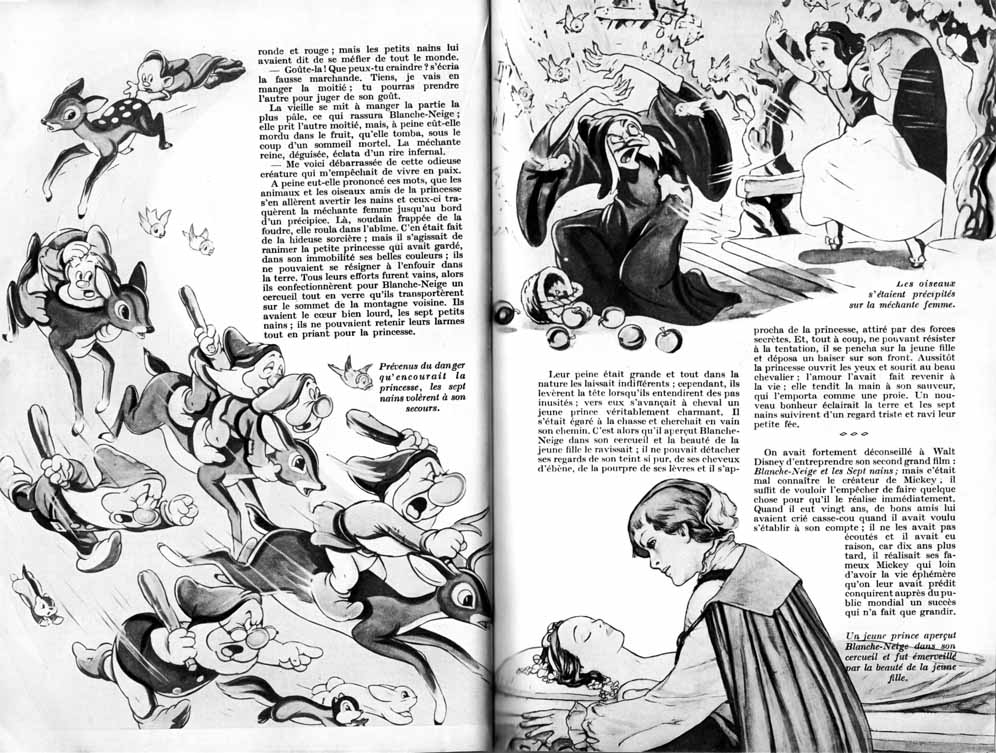
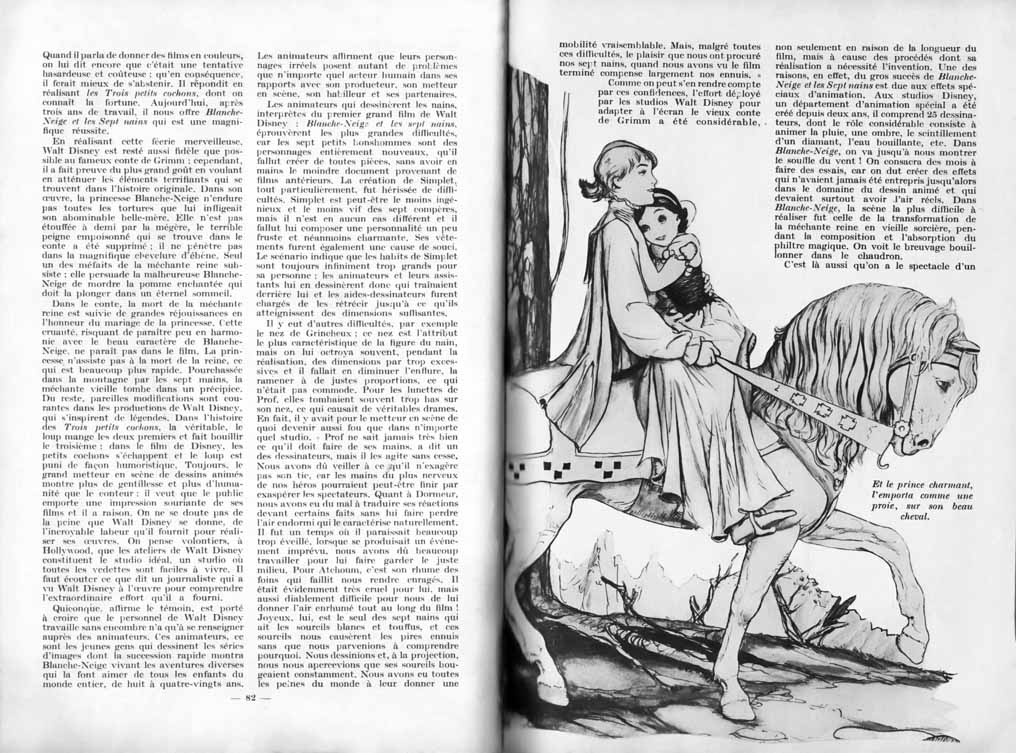
Walt Disney was strongly discouraged from making his second major film, Snow White and the Seven Dwarfs, but this was to misunderstand the creator of Mickey Mouse: just try to stop him from doing something, and he’ll immediately make it. When he was twenty, some good friends had cried “daredevil” to him when he wanted to set up on his own; he didn’t listen to them, and he was right, for ten years later, he was making his famous Mickeys, which, far from having the short-lived life predicted for them, conquered a worldwide audience that has only grown in popularity.
When he talked about making color films, he was again told that it was a risky and costly venture, and that he’d better refrain. He responded by making The Three Little Pigs, whose fortunes are well known. Now, after three years’ work, he has brought us Snow White and the Seven Dwarfs, a magnificent success.
In creating this marvelous fairy tale, Walt Disney remained as faithful as possible to Grimm’s famous tale; however, he showed great taste in toning down the terrifying elements found in the original story. In his work, Princess Snow White does not endure all the tortures inflicted on her by her abominable stepmother. She is not choked half to death by the vixen, and the terrible poison comb found in the fairy tale has been removed; it does not penetrate her magnificent ebony hair. Only one of the Evil Queen’s misdeeds remains: she persuades the unfortunate Snow White to bite the enchanted apple that will plunge her into eternal sleep.
In the fairy tale, the death of the Evil Queen is followed by great rejoicing in honor of the princess’ wedding. This cruelty, which might seem out of harmony with Snow White’s beautiful character, does not appear in the film. The princess does not witness the Queen’s death, which is much quicker. Chased up the mountain by the seven dwarfs, the wicked old woman falls into a precipice. Similar changes are common in Walt Disney productions inspired by legends. In the true story of the Three Little Pigs, the wolf eats the first two and boils the third; in the Disney film, the little pigs escape and the wolf is humorously punished. Always, the great cartoon director shows more kindness and humanity than the storyteller – he wants the audience to take away a smiling impression of his films, and he’s right. We have no idea how much trouble Walt Disney goes to, how much hard work he puts into making his films. In Hollywood, we like to think of Walt Disney’s studios as the ideal studio, a studio where all the stars are easy to live with. You have to listen to a journalist who has seen Walt Disney at work to understand the extraordinary effort he has put in.
Anyone who believes that Walt Disney’s staff are working without a hitch need only ask the animators. These animators are the young people who draw the series of images in rapid succession that show Snow White living the diverse adventures that have endeared her to children the world over, from the age of eight to eighty.
The animators claim that their unreal characters pose as many problems as any human actor in their dealings with their producer, director, dresser and partners.
The animators who drew the dwarfs in Walt Disney’s first major motion picture, Snow White and the Seven Dwarfs, found it extremely difficult, as the seven little men were entirely new characters who had to be created from scratch, without any documentation from previous films. The creation of Dopey, in particular, was fraught with difficulties. Dopey may be the least ingenious and the least lively of the seven companions, but he’s by no means different, and we had to create a personality for him that was a little crude yet charming. His clothes were another cause for concern. The script indicates that Dopey’s clothes are always infinitely too big for him, so the animators and their assistants drew him some that were trailing behind him, and the assistant draftsmen were tasked with shrinking them until they reached sufficient dimensions.
There were other difficulties, such as Grumpy’s nose, which is the most characteristic feature of the dwarf’s figure, but it was often over-dimensioned during production, and the swelling had to be reduced to just the right proportions, which was no easy task. As for Doc’s glasses, they often fell too low on his nose, causing real drama. In fact, the director could go as crazy as he would in any studio. “Doc never quite knows what to do with his hands,” said one of the designers, “but he’s always waving them around. We had to make sure he didn’t exaggerate his tic, because the hands of the most nervous of our heroes could perhaps end up exasperating the audience. As for Sleepy, we had a hard time translating his reactions to certain facts without making him lose his naturally sleepy air. There was a time when he seemed far too awake when an unforeseen event occurred, and we had to work hard to get him to strike the right balance. For Sneezy, it was his hay fever that nearly drove us mad. It was obviously very cruel for him, but also devilishly difficult for us to make him look like he had a cold throughout the film! Merry, on the other hand, is the only one of the seven dwarfs with bushy white eyebrows, and those eyebrows caused us the most trouble, though we couldn’t figure out why. We were drawing, and when we projected, we noticed that his eyebrows were constantly moving. We had the hardest time in the world getting them to move in a plausible way. But, in spite of all these difficulties, the pleasure our seven dwarfs gave us when we saw the finished film more than made up for our troubles.”
As can be seen from these confidences, the effort expended by Walt Disney Studios in adapting Grimm’s old fairy tale for the screen was considerable, not only because of the length of the film, but also because of the processes that had to be invented to produce it. Indeed, one of the reasons for the huge success of Snow White and the Seven Dwarfs was the special animation effects. At Disney Studios, a special animation department was created two years ago, comprising 25 artists, whose considerable role is to animate rain, a shadow, the sparkle of a diamond, boiling water and so on. In Snow White, they even go so far as to show us the breath of wind! Months were spent on testing, creating effects that had never been attempted before in the field of cartooning, and above all had to look real. In Snow White, the most difficult scene to realize was the transformation of the Evil Queen into an old hag, during the composition and absorption of the magic potion. The beverage is seen bubbling away in the cauldron.
This is also where we see the spectacle of a gust of wind. This effect is achieved by showing the course of the clouds in the sky, the movement of the puffs of fog, the rustling of drapes and clothes just sketched enough to give the spectator an imaginative vision of the path blown by the wind. The audience sees the potion at work as the Queen sees the scene with her own eyes. She then becomes dizzy, the room begins to spin in circles, and the scene ends in a whirlwind of color. For the rain effects, we studied the impact of water on any object and the appearance of wet clothes. Shadow effects were found by observing the kind of shadow that produced light of a given intensity, and its deformation after hitting an obstacle. An enormous and thankless task, but one of the most interesting ever accomplished in a studio.
We would have many curious details to provide about the music that plays a considerable role in Snow White, but it would be too long and we would risk tiring our readers. Let’s just say that of all the scenes in the film in which noises were difficult to render, none gave more trouble to the musicians and sound engineers than the one in which the seven dwarfs had to play an orchestra built by themselves. We realized that we couldn’t use an ordinary organ; the key had to be an instrument cobbled together by an amateur. We scoured the junk heap in the hope of unearthing bizarre musical instruments; in the end, it was with the means at hand, we mean in the studio, that we achieved the desired sound effects. Curious tones were obtained by blowing into bottles partially filled with water. Clarinets without mouthpieces were used, bassoon reeds were adapted to trombones, and an ocarina was added. To prevent the tone from varying, the water bottles had to be kept from changing temperature. This organ can be heard in the scene showing the seven dwarfs giving a concert to Snow White in their little house lost in the forest.
Do we want numbers now? Pioneering work is always difficult and expensive. The film of Snow White and the Seven Dwarfs, which lasts over an hour and a half, is made up of 230,000 drawings, with background music provided by an 80-strong orchestra; 600 artists worked on this production for over three years. These included: 32 animators, 102 assistants, 18 helpers, 20 draftsmen-directors, 24 watercolor background artists, 85 effects artists (those drawing smoke, water, clouds) and 158 expert young women who painted Disney characters on transparent celluloid sheets. Counting all the preliminary sketches, and bearing in mind that each drawing was drawn three or four times, we can estimate that at least two million drawings were made for Snow White. Finally, the production cost around $1,500,000, or over fifty million francs. But Walt Disney has been rewarded by tin triumph for his expense and effort. It’s only fair.
Such is the delightful tale that Walt Disney has told us, less in words than in drawings and colors.
